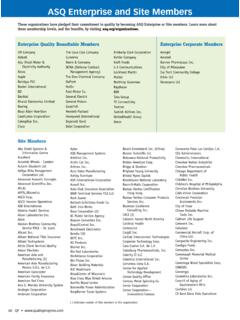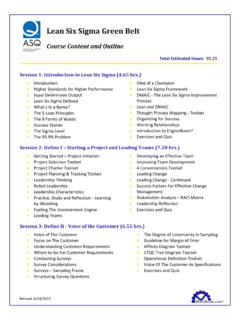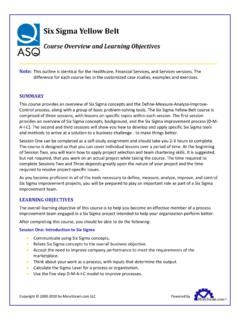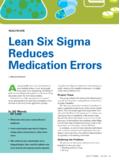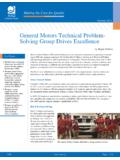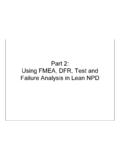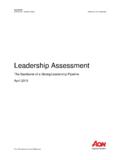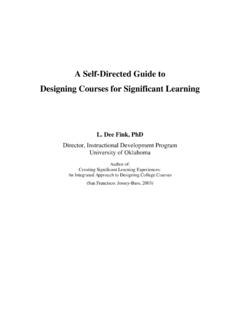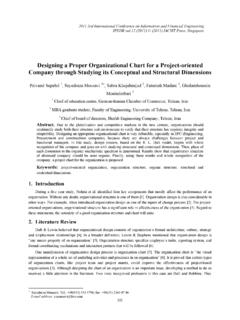Transcription of The ADDIE Model: Designing, Evaluating …
1 The ADDIE model : designing , Evaluating Instructional Coach Effectiveness By Shelby Danks, Hurst-Euless-Bedford Independent School District The era of accountability throughout the last decade has brought with it a demand for increased capabilities in today's educators. The elevated need for teachers to engage in the practices of effective instructional design, quality lesson delivery using research-based strategies, and data-enhanced reflection of student results has begun a flurry of interest in a form of professional development known as instructional coaching. Specifically, districts that have begun the improvement journey using the Baldrige Criteria for Performance Excellence may experience an even greater sense of urgency to develop their teachers and leaders as key elements to improving overall organizational results. Recent literature and conversations have demonstrated great strides in identifying the proper role of the instructional coach, as well as key practices coaches can use to support the work of their campuses.
2 Very little information, however, has surfaced in the public education community that describes specific, systematic processes that coaches can use to evaluate the impact and effectiveness of their support. Some of the key questions about instructional coaching that remain for district leaders and funders of these programs include: 1. How does an instructional coach design their work functions to ensure proper alignment to student, teacher, principal and federal needs? 2. How does an instructional coach evaluate his or her effectiveness and impact? 3. How does an instructional coach personally model the usage of a systematic learning process and data-enhanced decision making? By using the Analysis-Design-Develop-Implement-Evalua te ( ADDIE ) model of instructional design, the instructional coach can effectively demonstrate a proper return on expectation for each of his or her intended stakeholders.
3 The ADDIE model The ADDIE model is a five-step instructional design and project management tool borrowed from the field of human performance technology (HPT) and is commonly used to ASQ Primary and Secondary Education Brief September 2011 (Vol. 4, No. 5). develop, implement and evaluate performance improvement services. Some of the core values and principles that govern the use of the ADDIE model in HPT include: A focus on outcomes. A systems perspective. The intent to add value. The effort to be systematic in all aspects of the design of interventions and solutions. For a full description of each of the steps used in the ADDIE process, please refer to the Handbook of Human Performance Technology (Stolovitch and Keeps, 1999). ADDIE for Instructional Coaches While the job description of an instructional coach may be clearly communicated to the coach, the campus administrator, and even to teachers, it may still remain unclear what the goals of the support position will be, how the support will be structured to best address needs, and how the stakeholders will know whether these key support mechanisms, such as coaching, training and modeling, are effective.
4 The following chart (Figure A) summarizes how the ADDIE . model might be adapted by an instructional coach to analyze stakeholder needs, design a support logic model , develop key work functions, implement the key work functions, and evaluate the effectiveness of each key work function. Date Process Key Activities Step Before Analyze Collaborate with site administration to determine perceived needs of staff academic Conduct members. year needs Analyze campus performance results and improvement areas, as well as analysis other evaluation tools, to determine additional requirements and needs. Calculate and report results from these findings. Before Design Use data and information to draft logic model and project scorecard. academic Design Report data to site administration and other stakeholders. year support model Use results to list and describe the specific key work functions.
5 Early in Develop Develop data management strategy and tools. academic Develop key Communicate goals to all relevant stakeholders. year work functions ASQ Primary and Secondary Education Brief September 2011 (Vol. 4, No. 5). Through- Implement Use the PDSA model , quality tools, and other question stems to formally out year Implement the reflect on the effectiveness of each function. key work Maintain accurate records of each activity and document ideas and offerings functions on the key work functions. End of Evaluate At the end of the year, conduct EOY evaluations; analyze survey or focus year Evaluate the group results and organizational results to determine whether key goals impact of each were met. function Present findings (SWOT Analysis) to site leadership and make recommendations for following year. Figure A: An Adapted ADDIE model for Instructional Coaching Developed by S.
6 Danks, 2009. Analysis. During the analysis phase, the instructional coach collaborates with the site administration to determine the perceived needs of staff members. Using this input, the coach uses follow-up strategies, for example, surveys, focus groups and interviews, to collect additional data to determine the current levels of performance for each area of focus. In addition, the coach analyzes the campus's current student performance and other organizational results and improvement documents to ensure the needs align with the current direction and initiatives of the campus. Once additional data are obtained, it can be summarized to communicate to each of the relevant stakeholder groups (see Figure B). Frequency of Confidence/Frequency by Grade Level Data Analysis by Frequency of Data Item Analysis Confidence in Data Analysis PreK. Sixth Fourth Kindergarten First Third Second Fifth All Grades Grand Total Confidence in Classroom CI.
7 Figure B: Example of Results Obtained from BOY Survey about Frequency and Confidence in Data Analysis ASQ Primary and Secondary Education Brief September 2011 (Vol. 4, No. 5). Design. Once the instructional coach collaborates with its stakeholder groups to complete the analysis step, the design of a support logic model can help clarify the customer requirements, goals, measures, key work functions and function checks for each of these stakeholder groups (Figure C). Goals can be written to address each of the levels of the ROI Methodology (Phillips and Phillips, 2007): Satisfaction/reaction/confidence Learning Application/implementation Organizational impact ROI. Key Customer Outputs Strategic Goals Performance Key Work Function Checks Requirements Measures Functions (Formative). Support with data- Increased use By the end of the Average score of 1. DATA # of meetings driven decision- of school year, all teachers indicating ANALYSIS attended making (analysis of segmentation teachers will team FOR GRADE # of options student performance and quality indicate frequent implementation of LEVEL TEAMS offered data) and the tools to application of segmentation and # of options used measurement support deeper data analysis and quality tools as # of projects journey; development data analysis confidence in data Very frequent (or completed and use of necessary Confidence in analysis, as a score of 4); 2.
8 DATA # of meetings/. measures use and access measured by an Average score of ANALYSIS FOR conversations Support for special to additional average score of 4 teachers indicating SPECIAL attended projects in data data sets to or above in each a confidence level PROJECTS # of support analysis facilitate of these of 4 or higher in projects (Source: BOY improvement constructs on the segmentation and completed meetings with Instructional use of quality tools # of users administration and Support Survey. (see Survey) indicating BOY Survey) satisfaction (verbal). Provision of ideas and Increased By the end of the Average score of 3. TRAINING IN # of training instructional number of school year, all teachers indicating INSTRUCTIONAL sessions strategies ideas, teachers will learning and STRATEGIES conducted (Source: BOY strategies, and indicate increased implementation # of participants ASQ Primary and Secondary Education Brief September 2011 (Vol.))
9 4, No. 5). Survey/Requirements analysis tools learning and use (Retrospective learned Assessment) learned and of instructional consensograms; (consensogram). implemented strategies, as Survey) # of participants measured by used strategies session-specific, (consensogram). retrospective consensograms. Figure C: Excerpt from a Support Logic model Developed by S. Danks, 2009. Develop and Implement. Once the logic model has been designed, the instructional coach develops mechanisms to communicate it to key stakeholders. Next, he or she uses traditional Plan-Do-Study-Act methods to implement each of the support functions and monitors progress throughout the year in order to ensure that the tasks continue to meet needs, contribute to the development of innovative solutions, and facilitate improvement. Evaluate. Using the evaluation strategies described in the logic model , the instructional coach collects data at the end of the year to evaluate whether each of his or her key strategic goals have been met.
10 These results, as well as other results pertaining to satisfaction, knowledge, learning, etc. can be reported through graphs and charts that communicate the impact of the support functions offered by the coach (see example, Figure D). Percent Highly Satisfied or Satisfied by Work Function (of those who used the product/service). 100%. 100%. 98%. 96% 96%. 96%. 94%. Function 1: Data Analysis for Function 2: Data Analysis for Function 3: Training in Teams Special Projects Instructional Strategies Figure D: Example of Results Obtained from EOY Survey about Satisfaction with Functions Conclusions The ADDIE model is an effective, systematic model that can be adapted for use by instructional coaches to design, implement and evaluate the effectiveness of critical work ASQ Primary and Secondary Education Brief September 2011 (Vol. 4, No. 5). functions. By encouraging individual or organizationwide use of this model , all stakeholders can be better informed about the impact of the instructional coaching position on teacher capability, and by extension, student results.


